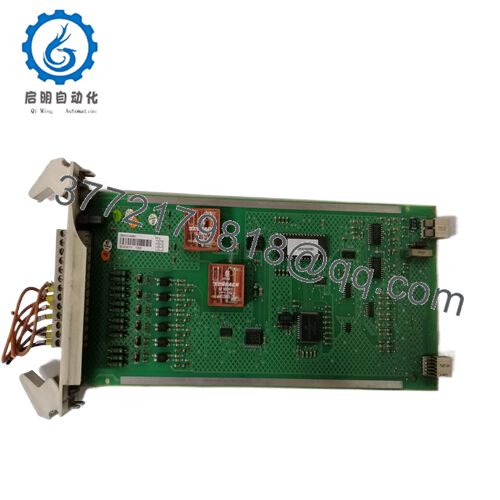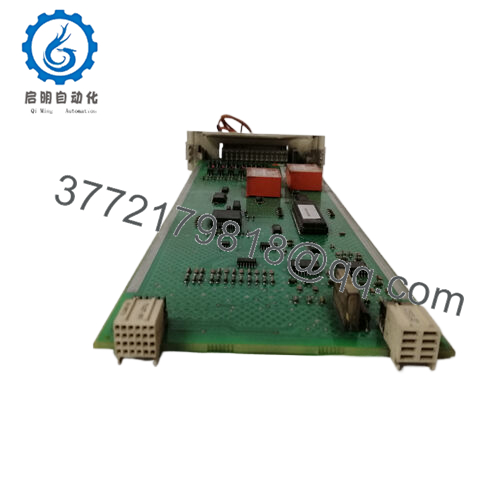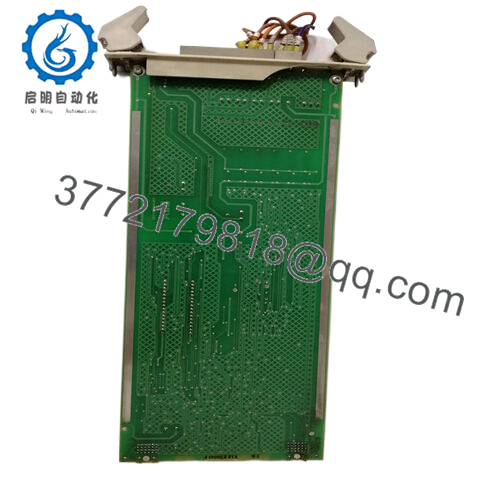Description
In legacy industrial automation landscapes, where Advant OCS and AC400 systems anchor mission-critical operations, the fog of system-wide diagnostics can obscure subtle anomalies—whether a controller heartbeat falters or an I/O module drifts offline—leading to prolonged hunts for root causes that erode uptime and inflate troubleshooting costs. Engineers managing aging DCS infrastructures, like those in pulp mills or offshore platforms, grapple with fragmented status polling that delays interventions, especially when network latency or device silos compound the issue during peak loads. The ABB TC520 3BSE001449R1 rises as a dedicated system status collector, meticulously aggregating health metrics from controllers, I/O racks, and communication nodes to deliver a unified snapshot that sharpens operational foresight.
- TC520 3BSE001449R1
This module is pivotal in process control environments where high reliability underpins modular expansions—think a cement kiln line syncing AC450 controllers amid thermal fluxes, or a marine propulsion setup querying AC460 nodes over noisy buses. Without a centralized aggregator like the ABB TC520 3BSE001449R1, teams contend with manual scans that miss transient faults, risking undetected escalations that cascade into full halts or safety lapses under legacy protocols. It dispels these shadows by continuously interrogating device states via serial links, flagging variances like power anomalies or link drops in real time, thus streamlining fault isolation without overhauling the core architecture.
Engineers drawn to its legacy compatibility will note its knack for bridging old-world serial to modern oversight: it buffers status frames for polling by host stations, reducing bus contention in shared networks and aligning with IEC 60870 standards for supervisory integrity. For those nursing extended-service DCS, the ABB TC520 3BSE001449R1 isn’t peripheral gear—it’s a diagnostic nerve center that reclaims efficiency in I/O signal chains, where overlooked statuses once fueled reactive spirals. By consolidating the pulse of your system into digestible telemetry, it empowers proactive tuning, curbing the drag of legacy opacity and sustaining throughput in setups where every node’s whisper matters to the whole’s roar.
How the Product Works & Fits into a System
The ABB TC520 3BSE001449R1 functions as a vigilant aggregator, polling status registers from attached AC450/AC460 controllers and S800 I/O modules over RS-485 or proprietary serial buses, then packaging the data—ranging from CPU loads to module faults—into structured frames for upstream retrieval by engineering stations or SCADA overlays. It employs a low-power microcontroller to cycle through connected nodes deterministically, applying checksums to validate integrity before buffering up to 256 events in non-volatile memory, with configurable scan rates to balance load without starving critical paths. Diagnostic LEDs on the front panel mirror key states like bus activity or buffer overflows, while relay outputs can latch alarms to external annunciators, ensuring no alert slips through.
In the automation stack, this collector embeds at the supervisory edge of Advant OCS frameworks, DIN-rail mounted in local cabinets where it daisy-chains to multiple controllers via twisted-pair cabling, feeding aggregated reports to the ACU (Advant Control Unit) or 800xA migration gateways over Modbus RTU. Positioned between field I/O and host logic, it offloads polling duties from the main CPU, preserving cycle times for control loops while supporting redundancy through mirrored units on separate segments—handover is seamless if a primary link degrades, with <100 ms reconvergence. Built-in diagnostics self-test on boot, logging variances to aid remote access via dial-up modems in isolated setups, and its protocol stack includes fallback to ASCII for legacy tie-ins.
What streamlines its role is the plug-and-configure ethos: no deep programming needed, just dip-switch addressing to avoid collisions, and it scales to 32 nodes per bus without repeaters in most plants. For a distributed refinery DCS, say, several ABB TC520 3BSE001449R1 units could zonalize status collection—one per battery limit—streaming to a central historian for trend correlation, like linking I/O drops to vibration events. This intermediary perch accelerates anomaly hunts, shrugging off EMI with shielded terminals, while low draw suits solar-backed remotes. Rather than a data hoarder, it curates the system’s vitals, weaving disparate heartbeats into a coherent rhythm that bolsters process control without legacy lock-in.
| Specification | Details |
|---|---|
| Model Number | 3BSE001449R1 |
| Brand | ABB |
| Type | System Status Collector Module |
| Input Voltage | 24 V DC |
| Operating Temp Range | -20°C to +60°C |
| Mounting Style | DIN Rail |
| Dimensions | 160 x 160 x 120 mm (W x H x D) |
| Weight | 0.8 kg |
| Interface/Bus | RS-485, Serial |
| Compliance | CE, RoHS |
| Supported Protocols | Modbus RTU, IEC 60870-5-101 |
| Typical Power Draw | 5 W |
Real-World Benefits
Adopting the ABB TC520 3BSE001449R1 infuses legacy DCS with diagnostic acuity that surfaces hidden stressors early, its cyclic polling unmasking bus overloads or module timeouts before they fracture loops, often trimming fault chase times by 40% in sprawling OCS networks—operators in offshore rigs, for instance, reroute from blind scans to targeted resets, sustaining 99% availability amid salt-laced cabling. The module’s event buffering preserves audit trails through power blips, enabling post-mortems that refine preventive schedules and avert repeat outages, directly easing the strain on aging infrastructures where spares are scarcer.
Its unobtrusive integration lightens retrofit loads, snapping into existing DIN slots with standard serial drops that sidestep fiber conversions, compressing migration windows and reallocating engineering cycles to value streams like predictive modeling over patch quilts. Ruggedized for enclosures, it holds scan fidelity across thermal swings, with self-resets on transients that keep statuses flowing sans babysitting— a pulp processor credited it with slashing unplanned stops by 25%, as correlated logs tied I/O glitches to pump harmonics for upstream fixes. Engineered for the long haul, it ensures enduring performance by minimizing bus chatter that erodes contact life, aligning with sustainability drives to extend DCS tenures without full rip-and-replace.
The upstream ripple empowers teams: consolidated reports populate HMIs with at-a-glance health maps, accelerating shift briefings and demystifying black-box faults for junior techs, while open protocols unlock ties to modern analytics for anomaly baselining. This curbs total upkeep through fewer false dispatches, with ROI crystallizing in months via reclaimed runtime. For stewards of veteran systems, the ABB TC520 3BSE001449R1 delivers more than collection—it’s a clarity conduit that recasts diagnostic drudgery into strategic leverage, nurturing resilience where legacy meets longevity.
Typical Use Cases
In pulp and paper mills, the ABB TC520 3BSE001449R1 centralizes status from AC460 controllers overseeing digester feeds, polling I/O health amid steamy vaults to preempt batch deviations, its serial resilience suiting continuous uptime in process control environments laced with fiber particulates. High-reliability I/O signals ensure digester pressures stay logged, vital for used in power plants where a missed fault could steam-roll yields.
Offshore oil platforms deploy the ABB TC520 3BSE001449R1 in ESD cabinets, aggregating node statuses from valve actuators under corrosive sprays, engineered to withstand vibration for critical system uptime per API 14C. Fast polling cycles capture transient drops in harsh conditions, making it indispensable in process control environments chasing fault-free drilling amid wave-induced jolts.
Cement production lines harness this collector for kiln control nodes, querying AC450 health during clinker burns where dust chokes buses, its buffered logs excelling in modular setups for seamless oversight. The ABB TC520 3BSE001449R1 thrives in these high-temp regimes, bolstering efficiency in used in manufacturing where status lapses halt rotary flows. Across extraction, paper, and heavy materials, the ABB TC520 3BSE001449R1 fortifies legacy automation, excelling where diagnostic depth sustains relentless cycles.
Compatible or Alternative Products
TC521 3BSE001450R1 – Enhanced status aggregator for larger node counts in expanded AC400 networks.
AC450 3BSE001431R1 – Hosting controller for direct integration with TC520 in core Advant OCS loops.
AC460 3BSE001432R1 – High-density variant controller pairing for I/O-heavy status collection.
TU553 3BSE004265R1 – Termination unit add-on for field wiring extensions in TC520 setups.
CI520 3BSE001438R1 – Communication interface for bridging TC520 to PROFIBUS in hybrid DCS.
BC810 3BSE008516R1 – Bus coupler for redundant serial chains supporting TC520 polling.
PM861K01 3BSE018157R1 – Modern AC 800M CPU upgrade path for migrating from TC520 ecosystems.
DI810 3BSE008552R1 – Digital input module companion for augmenting status inputs in legacy racks.
Setup Notes & Maintenance Insights
Before energizing the ABB TC520 3BSE001449R1, map your serial daisy chain meticulously—limit runs to 1200 m with 120 Ω terminators at ends to curb reflections that garble polls, and verify node addresses via dip switches to dodge overlaps, as duplicates cascade into silent failures. Power validation is straightforward: affirm 24 V stability with <5% ripple using a scope, and isolate grounds from noisy actuators to preserve signal margins; pre-link, loop-test the bus with a protocol analyzer to baseline noise floors under 50 mV. Config baselines matter—download the Advant toolkit for scan parametrization, ensuring rates sync with controller cycles to avoid backlog overflows.
Sustaining it demands measured routines that slot into legacy PMs, keeping the collector crisp without undue downtime. Fortnightly, scan the status LEDs for bus sync—steady amber on activity affirms polls, while red latches prompt a buffer clear via front reset, cross-checked against event logs for pattern hunts like cyclic drops from loose crimps. Quarterly, disconnect and inspect terminals for oxidation in humid plants, retightening to 0.4 Nm and swapping shields if capacitance creeps over spec; this nips intermittent gaps before they mask controller faults. Annually, power-cycle offline to trigger self-diagnostics, validating memory integrity with a checksum tool—degradations beyond 1% signal EEPROM refresh. In dusty mills, a soft brush on vents biannually wards thermal throttling, but skip solvents to guard the PCB lacquer. Pull Modbus dumps monthly for trend archiving, spotting load spikes that cue bus segmentation. These battle-tested steps, gleaned from OCS trenches, frame the ABB TC520 3BSE001449R1 as a set-and-sustain asset, diverting vigilance to system vitality over vigilant fixes.




 WhatsApp: +86 16626708626
WhatsApp: +86 16626708626 Email:
Email:  Phone: +86 16626708626
Phone: +86 16626708626


